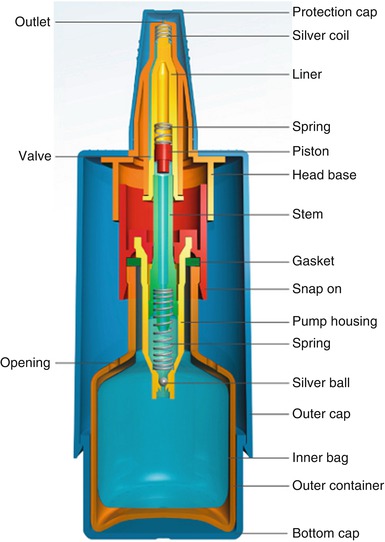Fig. 4.1
Preservative-free unit-dose vials

Fig. 4.2
COMOD® system for preservative-free multidose containers
AT consists of an active ingredient that promotes ocular surface wetting, buffering agents, preservatives, electrolytes, and other factors that vary widely from product to product. There are a variety of AT products on the market with different characteristics that may differently benefit specific types of ocular surface and tear dysfunction cases. The concept of customization of AT is related to an advanced understanding of the ocular surface and tear film and to the properties of different compounds available on AT. Specific deficiencies may be detected on each patient, to that an optimized AT selection is possible for enhancing patient benefit.
Components of ATs
Active ingredient to promote ocular surface wetting
Buffering agents
Preservatives
Electrolytes
Properties
Reduce clinical signs and symptoms.
Protect ocular surface.
Promote ocular surface wetting.
Various diagnostic measures are used to specify the best indication and to determine the efficacy of an AT. Tear film breakup time (TFBUT), corneal and conjunctival vital dye staining, and symptom questionnaires are among the most common measures. Objective information from systems as the Keratograph 5 (Oculus, Wetzlar, Germany) helps to evaluate tear substitute treatments. This chapter reviews the basics for understanding the most common formulations available for AT.
Most dry eye sufferers primarily manage their dry eye with OTC artificial tears (AT) or tear substitute eyedrops
It is estimated that over ten million Americans use AT.
Different ATs are available on the market with different properties.
4.1 General Aspects of Tear Substitutes
4.1.1 Viscosity Properties
Viscosity, or fluid thickness, has been considered one of the most important properties of an AT. Higher viscosity leads to longer retention of the agent in the ocular surface, which is beneficial in terms of relieving the signs and symptoms related to dry eye or dysfunctional tear syndrome. However, the thicker constitution is prone to cause blurring of vision after instillation and may leave runoff residues on the eyelashes or lids as the solution dries out. The challenge for AT preparations is to accomplish a certain level of viscosity that maximizes its retention time and maintains visual clearness, thereby augmenting clinical efficacy (Bhojwani et al. 2011).
Increase AT Viscosity →
↑ retention time
↑ residues
↓ clarity of vision
4.1.2 Demulcent Agents
Demulcents are lubricating compounds contained in AT that have a mucilaginous consistency, which provides lubricity for protecting and smoothing the ocular surface, thereby minimizing abrasive actions of the eyelids. The US Food and Drug Administration (FDA) recognizes six categories of ophthalmic demulcents (Table 4.1).
Table 4.1
Categories of ophthalmic demulcents
Cellulose derivatives |
Liquid polyols |
Polyvinyl alcohol |
Gelatin |
Dextran 70 |
Povidone |
To be allowed in “over-the-counter” (OTC) preparations, the demulcents should fall within certain concentration ranges according to international standards. An AT may contain up to three demulcents in its preparations. An ophthalmic vasoconstrictor or a vasoconstrictor with astringent combination could be included to provide the AT with additional redness- or discomfort-reducing properties.
Cellulose derivatives are the most common demulcents found in modern tear substitutes. Their concentration range goes from 0.2 to 2.5 %. The two main cellulose derivatives available for AT preparations are hydroxypropylmethylcellulose (HPMC) and carboxymethylcellulose (CMC). Cellulose derivatives also function as viscosity agents if its concentration is increased, which prolongs its retention time in the ocular surface. Similarly, CMC preparations, typically presented in 0.5 or 1.0 % CMC, have different viscosity, with the higher concentration forming a thicker, gel-like liquid. In addition, cellulose-based demulcents can be combined with an oil in order to enhance its mucoadhesive properties, which improves either the mucin and lipid components of the tear film (Rieger 1990). CMC can also be combined with osmoprotectants such as glycerin, L-carnitine, and erythritol, which are biocompatible solutes that aim to protect cells from the physiological stress of exposure to hyperosmotic conditions. Altering these characteristics may be a strategy for deciding the concentration and composition of cellulose-derived AT in accordance with the type and severity of TDS. It has also been demonstrated in a recent study that CMC can have biological effects as it appears to stimulate the closure of epithelial cell wounds in vitro as well as re-epithelization in rabbit corneas in vivo (Garrett et al. 2008).
Cellulose derivatives may work as viscosity agents by increasing their concentration.
Cellulose demulcents could also be combined with an oil in order to enhance the mucoadhesive properties of the preparation.
Liquid polyols (polyhydric alcohols) are allowable in concentrations of 0.2–1.0 %. Polyols do not have viscosity properties and are only used as lubricants. Interestingly, a comparative study demonstrated that AT containing propylene glycol 0.3 % (PG) and polyethylene glycol 0.4 % (PEG 400) provided better lubricity and longer visual acuity maintenance than a tear containing cellulose-based demulcents. Polyols can be combined with mineral oil and phospholipids to create a stable emulsion and promote stabilization of the lipid layer, especially in patients with meibomian gland dysfunction. These patients can also benefit from lipid only containing artificial tears, such as castor oil and mineral oil.
Stay updated, free articles. Join our Telegram channel

Full access? Get Clinical Tree


